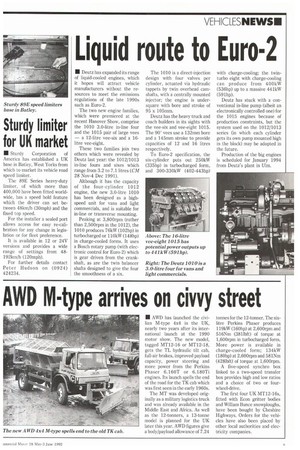Liquid route to Euro-2
Page 11

If you've noticed an error in this article please click here to report it so we can fix it.
• Deutz has expanded its range of liquid-cooled engines, which it hopes will attract vehicle manufacturers without the resources to meet the emissions regulations of the late 1990s such as Euro-2.
The two new engine families, which were premiered at the recent Hanover Show, comprise the 1010 3.0-litre in-line four and the 1015 pair of large vees — a 12-litre vee-six and a 16litre vee-eight.
These two families join two others which were revealed by Deutz last year: the 1012/1013 in-line fours and sixes which range from 3.2 to 7.1 litres (CM 28 Nov-4 Dec 1991).
Although it has the capacity of the four-cylinder 1012 engine, the new 3.0-litre 1010 has been designed as a highspeed unit for vans and light commercials, and is suitable for in-line or transverse mounting.
Peaking at 3,800rpm (rather than 2,500rpm in the 1012), the 1010 produces 76kW (102hp) in turbocharged or 110kW (148hp) in charge-cooled forms. It uses a Bosch rotary pump (with electronic control for Euro-2) which is gear driven from the crankshaft, as are the twin balancer shafts designed to give the four the smoothness of a six. The 1010 is a direct-injection design with four valves per cylinder, actuated via hydraulic tappets by twin overhead camshafts, with a centrally mounted injector; the engine is undersquare with bore and stroke of 95 x 105mm.
Deutz has the heavy truck and coach builders in its sights with the vee-six and vee-eight 1015. The 90' vees use a 132mm bore and a 145mm stroke to provide capacities of 12 and 16 litres respectively.
To Euro-2 specification, the six-cylinder puts out 250kW (335hp) in turbocharged form, and 300-330kW (402-443hp) with charge-cooling; the twinturbo eight with charge-cooling can produce from 400kW (536hp) up to a massive 441kW (591hp).
Deutz has stuck with a conventional in-line pump (albeit an electronically controlled one) for the 1015 engines because of production constraints, but the system used on the 1012/1013 series (in which each cylinder gets its own pump mounted high in the block) may be adopted in the future.
Production of the big engines is scheduled for January 1994 from Deutz's plant in Ulm.




















































































